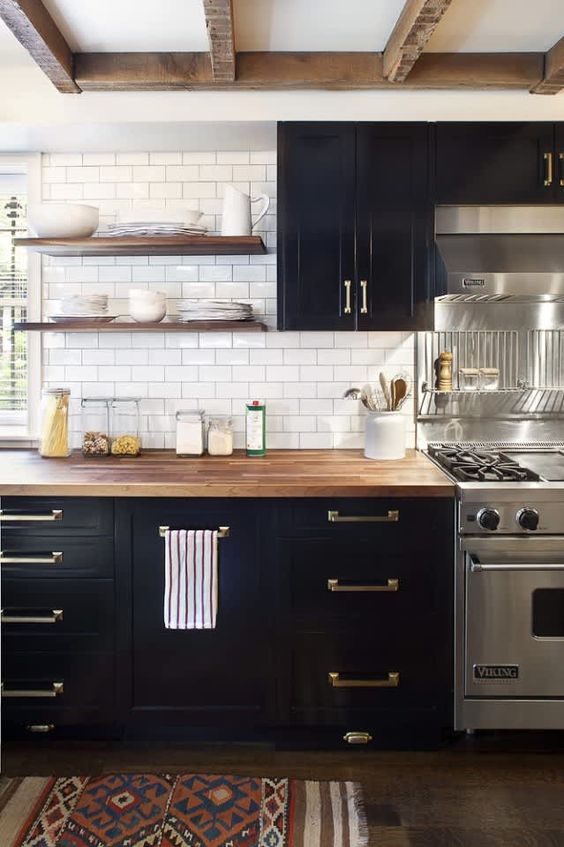A butcher block is a sturdy countertop made from glued wood strips. Often made from maple for its toughness and nice grain, it fits well in kitchens with a cozy, rustic, or traditional look, adding warmth and timeless beauty. It can also add a surprising twist to modern spaces.
With regular care, butcher block countertops age well. But without proper upkeep, they can wear out and crack. So, is the butcher block right for your kitchen? How does it help your home? Keep reading to learn about the advantages and care tips for these countertops.

What is a Butcher Block Countertop?
Butcher block countertops, popular in cozy cottages and rustic farmhouses, are made from hardwood planks fused together. They offer a timeless, warm appeal unlike any other material and bring a touch of nature into the kitchen. Made from natural materials, they’re environmentally friendly and biodegradable.
These countertops come in various styles and colors, made from different woods like maple, cherry, walnut, and oak. Butcher blocks can be crafted in several ways: for edge grain blocks, straight wood pieces are glued into slabs; for blended grain blocks, rails of varying lengths are joined, laminated, and bonded together.

How Does A Butcher Block Countertop Benefit You?
Versatility
In addition to the more common woods like cherry, oak, and walnut butcher block countertops may also be made from bamboo, mahogany, tigerwood, zebrawood, wenge, beech, hickory, and mahogany. Additionally, butcher block often comes in edge grain, end grain, or mixed designs.
Longevity
With routine upkeep, butcher block may endure for around 20 years, which puts it on par with granite surfaces. Usually, butcher block counters outlive laminate ones.
Easy to Clean
There is no need for unusual cleaning agents on the butcher block. Usually, a sponge is soaked in two cups of warm water and a teaspoon of dish soap. Apply some vinegar to the butcher block to clean it. Put vinegar over the stain and scrub the area with half a lemon to remove a butcher block stain.
Simple to Refinish
Others would see this as a drawback, but if you need to repair a butcher block due to nicks or dents, you must smooth it down. To remove the damaged areas off the butcher block, use fine-grit sandpaper, such as 220-grit, and then re-oil the top with food-safe oil.

Precautions While Using Butcher Block Countertop
Scratches And Stains
Harder woods may not be as prone to scratches as softer ones, but if not cleaned immediately, any wood will discolor. A butcher block countertop is often used as a cutting board. However, doing so invites bacteria, mildew, and even warping. The butcher block must be sealed after installation and then once a month to avoid such problems. Find an oil that is appropriate for the butcher block’s kind of wood.
Drying Out
There is always a potential that any wood product might dry out. Butcher block countertops have to be regularly coated with food-grade mineral oil to avoid drying out.
Unable To Withstand Heat
The butcher block may burn if hot objects are put on it, necessitating refinishing to erase the burn mark.
Collects Dust
Butcher block surfaces need outstanding maintenance since crumbs and dust are more evident than stone surfaces.
Cost of Butcher Block Countertops

Butcher block countertops are an affordable alternative to stone, stainless steel, marble, and concrete, generally costing $20 to $60 per square foot. While less expensive than genuine stone, they’re pricier than laminate. Installation costs range from $50 to $70 per square foot, including labor.
Online prices vary, like a 74-inch Ikea countertop at $219 and a 72-inch Lowes option at $388.
While you can opt for DIY installation of butcher block countertops, hiring a contractor will cost you $5 to $10 per square foot to the total cost.
The Best Butcher Block Countertop Ideas

A classic butcher block countertop that rightly compliments the kitchen with hardwood flooring and pendant lighting.

Another one of the best butcher block countertops with white cabinets and rustic seating.

A modern farmohouse kitchen housing a stunning butcher block countertop island with luxurious pendant lighting.

Who says butcher block countertops only compliment white cabinets? Here’s a pictorial representation of butcher block countertops with black cabinets and brass hardware.

Check out this amazing kitchen remodeling idea with blue cabinets butcher block countertop backsplash and matching hardware.



A perfect example of a farmhouse kitchen housing a blue island with a butcher block countertop that also doubles as a dining area.


Frequently Asked Questions
How to finish butcher block countertop?
Before sealing, sand the top of your block counter using fine-grit sandpaper on an electric sander. For already-excellent surfaces, lower-intensity rotating sanders work well. The power of a belt sander’s wood-scouring ability will be helpful on rougher surfaces.
How to seal butcher block countertops?
Polyurethane-sealed butcher block counters will ultimately scratch and lose their finish. One suggestion is to use mineral oil as a sealer instead of bulky sealants. Utilizing clean cotton cloths, gently rub the lubricant on the top surface. Before fitting the sink, grease the inside and bottom of any openings.
How to care for butcher block countertops?
Butcher block countertops should, at the absolute least, be oiled every six months to ensure the timber is safe. It’s advisable to follow the suggestions of your installer since various kinds of wood need different finishing oils. Butcher block countertops could also need more regular conditioning and oiling, depending on how often they are used to keep the wood from splitting and becoming bland.
Related posts:
 Your Guide to the Best DIY Budget Kitchen Remodel Ideas
Your Guide to the Best DIY Budget Kitchen Remodel Ideas
 Outdated Kitchen Trends that You Must Stay Away From in 2022
Outdated Kitchen Trends that You Must Stay Away From in 2022
 The Most Stylish White Kitchen Faucet Ideas For A Headturning Space
The Most Stylish White Kitchen Faucet Ideas For A Headturning Space
 How to Remove Kitchen Sink Drain?
How to Remove Kitchen Sink Drain?
 L Shaped Kitchen Layout: Your Guide to a Trendy and Functional Space with an Island
L Shaped Kitchen Layout: Your Guide to a Trendy and Functional Space with an Island



